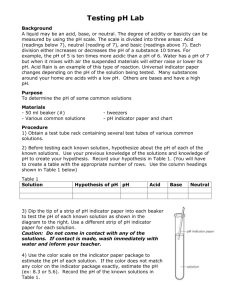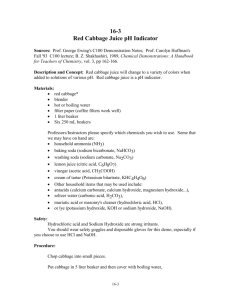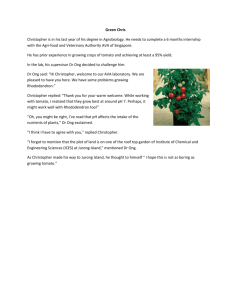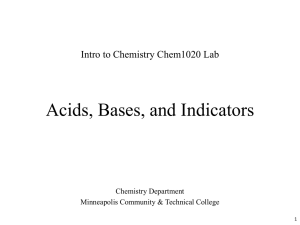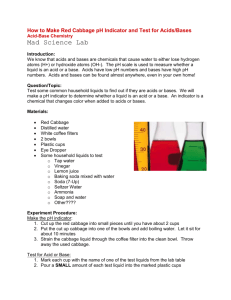This hands-on workshop is designed to teach students about acids
advertisement
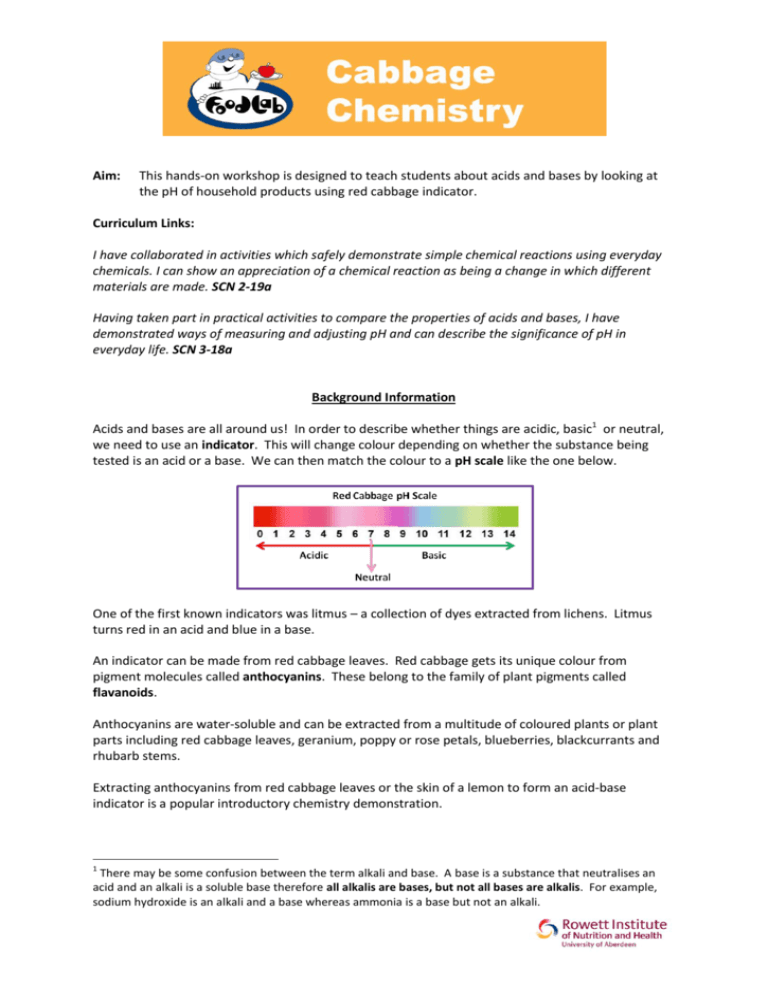
Aim: This hands-on workshop is designed to teach students about acids and bases by looking at the pH of household products using red cabbage indicator. Curriculum Links: I have collaborated in activities which safely demonstrate simple chemical reactions using everyday chemicals. I can show an appreciation of a chemical reaction as being a change in which different materials are made. SCN 2-19a Having taken part in practical activities to compare the properties of acids and bases, I have demonstrated ways of measuring and adjusting pH and can describe the significance of pH in everyday life. SCN 3-18a Background Information Acids and bases are all around us! In order to describe whether things are acidic, basic1 or neutral, we need to use an indicator. This will change colour depending on whether the substance being tested is an acid or a base. We can then match the colour to a pH scale like the one below. One of the first known indicators was litmus – a collection of dyes extracted from lichens. Litmus turns red in an acid and blue in a base. An indicator can be made from red cabbage leaves. Red cabbage gets its unique colour from pigment molecules called anthocyanins. These belong to the family of plant pigments called flavanoids. Anthocyanins are water-soluble and can be extracted from a multitude of coloured plants or plant parts including red cabbage leaves, geranium, poppy or rose petals, blueberries, blackcurrants and rhubarb stems. Extracting anthocyanins from red cabbage leaves or the skin of a lemon to form an acid-base indicator is a popular introductory chemistry demonstration. 1 There may be some confusion between the term alkali and base. A base is a substance that neutralises an acid and an alkali is a soluble base therefore all alkalis are bases, but not all bases are alkalis. For example, sodium hydroxide is an alkali and a base whereas ammonia is a base but not an alkali. Acidic solutions will turn the indicator red, neutral solutions result in a purplish colour and basic solutions appear greenish-yellow. Therefore, it is possible to determine the pH of a solution based on the colour it turns the pigments in red cabbage juice. Nutritional facts about red cabbage Red cabbage is low in calories and a good source of fibre and vitamins. Red cabbage has twice the vitamin C of green cabbage. Red cabbage contains lots of antioxidants which prevent damage to the body’s cells. Emerging evidence suggests that anthocyanins may provide cancer protection, improve brain function and promote heart health. Setting up the workspace for the experiment Because this experiment involves a lot of liquids, spillages may occur so consider covering the tables or conducting the experiment on trays. Although none of the substances being used are very harmful, participants should wear personal protective equipment of some sort to protect clothes and skin. For example, disposable aprons or lab coats, gloves (if available) and eye protection (if available). Students with long hair should tie it back. Equipment Required To prepare red cabbage indicator; Fresh red cabbage (approx 150g) Knife Chopping Board Hot water 2 x 2L beaker/container 2L plastic bottle Sieve To prepare test solutions; 5 plastic cups per group 5 stirrers per group Vinegar (acidic) Lemon juice (acidic) Water (neutral) Bicarbonate of soda (1 level teaspoon dissolved in water) (slightly basic) Milk of magnesia (basic) What to do BEFORE CLASS prepare the cabbage indicator as below; 1. Using the knife, chop up the red cabbage into strips. 2. Place the cabbage strips into one of the 2L containers and half fill it with hot water. 3. Leave to soak, stirring occasionally for a few minutes until the water becomes a deep purple colour. 4. Leave the solution to cool. 5. Strain the solution through the sieve into the 2L beaker. 6. Add sufficient water to the solution to make about 1L and transfer this to the 2L bottle for storage. NB. After preparation, make sure to test the indicator to ensure the colour will change. BEFORE CLASS 1. Place a small amount of each of the solutions to be tested in a plastic cup. Make sure each group of students has one cup of each solution. 2. Arrange the cups in the following order from left to right; 1 Acidic 2 Acidic 3 Neutral 4 Slightly Basic 5 Basic Vinegar Lemon Juice Water Bicarbonate of Soda Milk of Magnesia WITH THE CLASS 3. Give students a small introduction to the experiment using the information provided and describe how you prepared the cabbage indicator. 4. Split the students into small groups, let them guess what each of the test liquids are by looking at them and smelling them. Write down the answers in the results table. N.B. Draw particular attention to the water and the bicarbonate of soda. They look the same at this point. Get the students to guess what colour the water will go when indicator is added – they may find this tricky! You can remind them that there is already water in the indicator. 5. Get the students to add red cabbage indicator to the liquids using the plastic droppers (2 full droppers in each should be enough). They should then stir the solutions using a different stirrer for each one. Look carefully at the colour of the resulting liquid and compare it to the pH scale on the Background Information page. Record the results in the table below. Results Cup 1 2 Contents Vinegar Lemon Juice Colour Before Colour After pH Acid/Base/Neutral Clear Cloudy white/yellow Red/Pink 3 Acid Red/Orange 2 Acid 3 Water Colourless Purple See Footnote2 7 Neutral 4 Bicarbonate of Soda Milk of Magnesia Colourless Blue 10 Base Creamy White Green 12 - 13 Base 5 Conclusions Why did the cabbage water change colour when it was added to each of the different cups? The cabbage water acted as an indicator so changed colour depending on the pH of the substances being tested. If the sample was acidic, the indicator turned red. If the sample was neutral the indicator did not undergo a change and remained purple. If the substance was basic, the indicator turned blue/green. What would happen to the colour of the indicator if you mixed vinegar (containing indicator) and bicarbonate of soda? Why not get the students to predict what will happen and then demonstrate the experiment? The indicator would change from red in the vinegar (acid) to purple because the solution has been neutralised. There is acid in your stomach which helps to digest your food and sometimes, if the acid travels up towards your mouth, it causes a burning feeling in your chest called heartburn. Why do you think Milk of Magnesia is used to make this better? Milk of Magnesia is an alkali so helps to neutralise the acid. 2 This introduces the concept of test and control. In this experiment water is our control sample (because there is already water in the indicator) so the indicator remains purple. This makes sure the indicator is working properly and any colour changes seen in test samples are valid results. Exploring the Science Acids are often founds in the foodstuffs we eat and drink and tend to have a tangy taste that makes you pull faces! Think about lemons and limes for example or vinegar. Interestingly, bread, cheese and fizzy drinks are acidic too. These are all weak acids so they are safe for us to eat but, the acid in your stomach which digests your food is really strong. Some foods are basic, for example lettuce, green beans and spinach. We often use basic substances for cleaning because they are good at removing dirt and grease. Have a think about the liquids below. Do you think they are acids or bases? Fill in the table. Liquid Acid or base? Toothpaste* Lemonade Washing-up Liquid *mix with water before testing Base Acid Base Colour of indicator Purple/Blue Red/Pink Blue/Green Acid rain is very damaging. It is caused by gases from power stations being absorbed by rain drops in the sky. Acid rain can damage buildings (particularly those built of the basic substance limestone). It can also damage plants and cause harm to aquatic animals. Why not investigate this in more detail as part of a project on the environment? Other Demos to Try 1. For a more spectacular, teacher-led demo try getting a large glass beaker or measuring cylinder filled with indicator and drop some dry ice into it. Dry ice is solid carbon dioxide so, as it heats up and the bubbles of gas are released, the indicator will change colour. 2. Test the success of different antacids by using the same amount of each to neutralise an acidic solution. The higher the final pH, the better the antacid. Risk Assessment Although this experiment is very safe, it is worth keeping in mind the possible hazards and trying to prevent them. This risk assessment should help you to identify the risks and ways to minimise them. Brief Description of Experiment Cut red cabbage into strips and mix with hot water to give a pH indicator solution. Strain the solution. Mix the indicator with test solutions (see below) and observe colour change. Vinegar (acidic) Lemon juice (acidic) Water (neutral) Bicarbonate of soda dissolved in water (slightly basic) Milk of magnesia (basic) Risks Sharp knife could cause cuts. Hot water could cause burns. Vinegar irritant to eyes and skin. Lemon juice irritant to eyes and skin. Bicarbonate of soda irritant to eyes and skin. Milk of Magnesia irritant to eyes and skin. Action to be taken to minimise risks Only demonstrators to use knives to cut cabbage. Knives to be kept concealed and out of reach for the duration of the experiment. Only demonstrators to use hot water. Solution should be thoroughly cooled before use by students. Use small amounts of the chemicals. Use minimum strength of the chemicals. Make sure all spills are cleaned up immediately. Make sure all participants wear appropriate PPE. Supervise students at all times. Make sure participants wash hands after the experiment. Action to be taken in the event of an accident Call first aider in case of injury. Run affected area under cold water and call first aider. Flush affected skin or eye under running water and seek medical attention if irritation persists.
